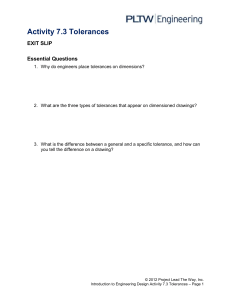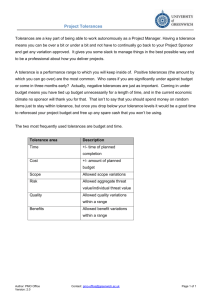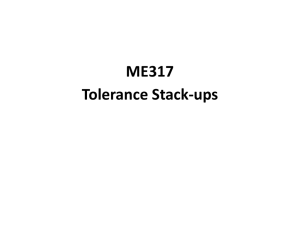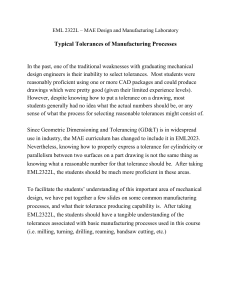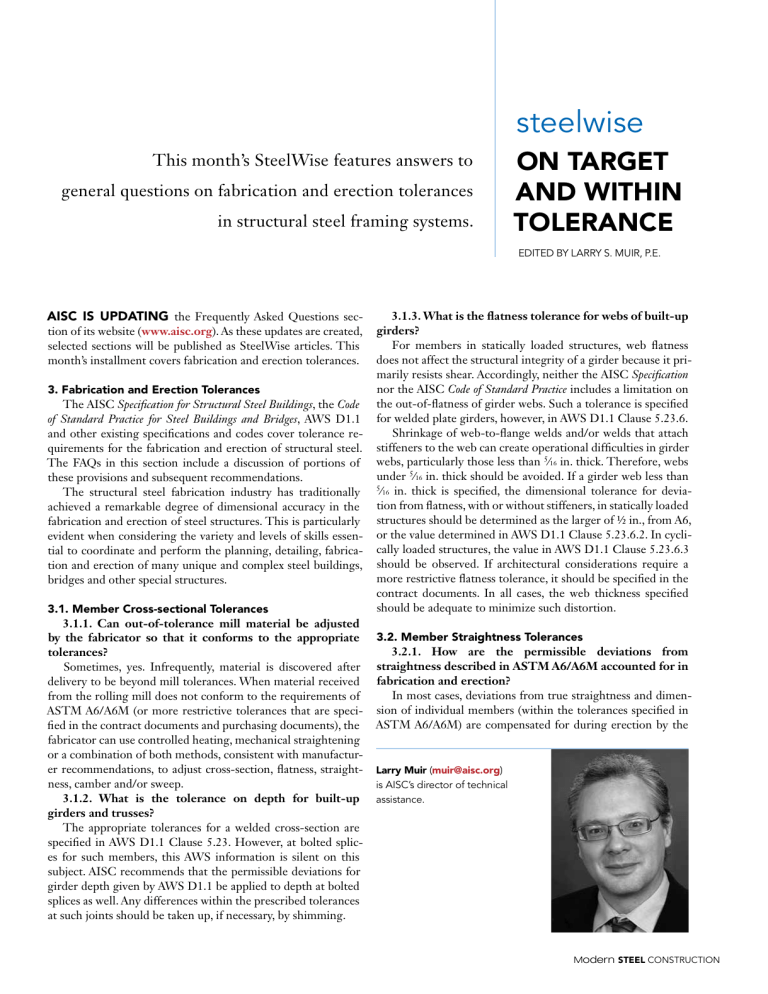
steelwise This month’s SteelWise features answers to general questions on fabrication and erection tolerances in structural steel framing systems. ON TARGET AND WITHIN TOLERANCE EDITED BY LARRY S. MUIR, P.E. AISC IS UPDATING the Frequently Asked Questions section of its website (www.aisc.org). As these updates are created, selected sections will be published as SteelWise articles. This month’s installment covers fabrication and erection tolerances. 3. Fabrication and Erection Tolerances The AISC Specification for Structural Steel Buildings, the Code of Standard Practice for Steel Buildings and Bridges, AWS D1.1 and other existing specifications and codes cover tolerance requirements for the fabrication and erection of structural steel. The FAQs in this section include a discussion of portions of these provisions and subsequent recommendations. The structural steel fabrication industry has traditionally achieved a remarkable degree of dimensional accuracy in the fabrication and erection of steel structures. This is particularly evident when considering the variety and levels of skills essential to coordinate and perform the planning, detailing, fabrication and erection of many unique and complex steel buildings, bridges and other special structures. 3.1. Member Cross-sectional Tolerances 3.1.1. Can out-of-tolerance mill material be adjusted by the fabricator so that it conforms to the appropriate tolerances? Sometimes, yes. Infrequently, material is discovered after delivery to be beyond mill tolerances. When material received from the rolling mill does not conform to the requirements of ASTM A6/A6M (or more restrictive tolerances that are specified in the contract documents and purchasing documents), the fabricator can use controlled heating, mechanical straightening or a combination of both methods, consistent with manufacturer recommendations, to adjust cross-section, flatness, straightness, camber and/or sweep. 3.1.2. What is the tolerance on depth for built-up girders and trusses? The appropriate tolerances for a welded cross-section are specified in AWS D1.1 Clause 5.23. However, at bolted splices for such members, this AWS information is silent on this subject. AISC recommends that the permissible deviations for girder depth given by AWS D1.1 be applied to depth at bolted splices as well. Any differences within the prescribed tolerances at such joints should be taken up, if necessary, by shimming. 3.1.3. What is the flatness tolerance for webs of built-up girders? For members in statically loaded structures, web flatness does not affect the structural integrity of a girder because it primarily resists shear. Accordingly, neither the AISC Specification nor the AISC Code of Standard Practice includes a limitation on the out-of-flatness of girder webs. Such a tolerance is specified for welded plate girders, however, in AWS D1.1 Clause 5.23.6. Shrinkage of web-to-flange welds and/or welds that attach stiffeners to the web can create operational difficulties in girder webs, particularly those less than 5∕16 in. thick. Therefore, webs under 5∕16 in. thick should be avoided. If a girder web less than 5∕16 in. thick is specified, the dimensional tolerance for deviation from flatness, with or without stiffeners, in statically loaded structures should be determined as the larger of ½ in., from A6, or the value determined in AWS D1.1 Clause 5.23.6.2. In cyclically loaded structures, the value in AWS D1.1 Clause 5.23.6.3 should be observed. If architectural considerations require a more restrictive flatness tolerance, it should be specified in the contract documents. In all cases, the web thickness specified should be adequate to minimize such distortion. 3.2. Member Straightness Tolerances 3.2.1. How are the permissible deviations from straightness described in ASTM A6/A6M accounted for in fabrication and erection? In most cases, deviations from true straightness and dimension of individual members (within the tolerances specified in ASTM A6/A6M) are compensated for during erection by the Larry Muir (muir@aisc.org) is AISC’s director of technical assistance. Modern STEEL CONSTRUCTION steelwise relative flexibility of the individual members compared to that of the overall structural steel frame they comprise. However, in some structures using heavy, rigid cross-sections, the stiffness of the member may preclude any adjustment of out-ofstraightness that, although within acceptable limits, can prevent tight fit-up of connections. This situation is most likely to occur with multi-story building columns and may cause difficulty in erecting the floor framing members. Although normal detailing practices may compensate in part for this problem, special shop layout practices often are essential for heavy, rigid framing. A straight working line should be established between member ends as defined by the AISC Code of Standard Practice Section 7.13. (See 3.5.3 as well.) 3.2.2. What tolerance is applicable for the camber ordinate when beam camber is specified? As indicated in AISC Code of Standard Practice Section 6.4.4, for members less than 50 ft long, the camber tolerance is -0 in., +½ in.; an additional 1∕8 in. per each additional 10 ft of length (or fraction thereof) is allowed for lengths in excess of 50 ft. An exception is also included: members received from the rolling mill with 75% of the specified camber require no further cambering. Furthermore, it is specified that camber be inspected in the fabricator’s shop in an unstressed condition. 3.2.3. What is the tolerance on sweep for curved girders? Permissible variations in sweep for horizontally curved welded plate girders are specified in AWS D1.1 Clause 5.23.5. If it is required to hold the ordinate of additional points along the beam within a certain tolerance, these requirements should be specified in the contract documents. Note, however, that most girders have sufficient lateral flexibility to easily permit the attachment of diaphragms, cross frames, lateral bracing, etc. without damaging the structural member or its attachment. 3.2.4. What is the tolerance on twist of welded box members? As stated in AWS D1.1 Clause 5.23.12: “[The tolerance on] Twist of box members…shall be individually determined and mutually agreed upon by the contractor and the owner with proper regard for erection requirements.” In the absence of a specified tolerance, an attempt is sometimes made to apply the provisions of ASTM A500 or ASTM A6/A6M. However, the provisions of these material specifications should not be applied to fabricated box members. In an un-spliced member, the necessary tolerance on twist is generally a matter of serviceability or aesthetics. In a member that will be spliced, twist must be kept within limits that remain erectable. Shop assembly of the entire member by the fabricator may be necessary to accomplish this. It is recommended that the fabricator and erector mutually agree on the means and methods necessary to achieve installation of an acceptable member in the completed structure (see 3.5.1). Connection details for fabricated box members should accommodate twist in the completed member. In any case, the required twist tolerance should be speciSEPTEMBER 2015 fied in the contract documents. However, because of high torsional strength and stiffness, correction of twist in a closed box or similar shape is nearly impossible and carries the potential for damage. If the actual twist of a fabricated member exceeds a specified tolerance, whether to attempt correction should be a case-bycase decision made by the structural engineer of record (SER). 3.3. Element Location Tolerances 3.3.1. Is a tolerance on hole or hole pattern location specified in the AISC Code of Standard Practice? No. Neither the ±1∕16-in. tolerance, where applicable, on overall length of members framed to other steel parts nor the 1∕16-in. clearance on size of standard holes should be construed as implying that the tolerance of ±1∕16 in. also applies either to the maximum tolerance on hole location within a pattern of holes or to the position of intermediate connections. 3.3.2. What is the tolerance on location of intermediate and longitudinal stiffeners? When intermediate stiffeners are spaced at a distance that is approximately equal to the girder depth, weld shrinkage up to 3∕8 in. in a 100-ft-long girder is not uncommon. Furthermore, thermal expansion or contraction in a like length of girder due to a temperature differential of 50 °F can cause a change in length of approximately 3∕8 in. In view of these and other factors, there is a need for a tolerance on the location of longitudinal stiffeners. Because AWS D1.1 Clause 5.23 is silent on this subject, AISC recommends the following criteria: 1. Intermediate stiffeners may deviate from their theoretical location ±2 in. as measured from the closest girder end. 2. Diaphragm and other connection stiffeners may deviate from their theoretical location by no more than twice the thickness of the stiffener. 3. Longitudinal stiffeners may deviate from their theoretical location by a distance equal to 1% of the girder depth. 4. If longitudinal stiffeners are interrupted by vertical stiffeners, the ends should not be offset by more than half the thickness of the longitudinal stiffeners. 3.3.3. When forces are to be transferred by contact bearing, is a gap allowed between the contact surfaces? AISC Specification Section M4.4 states: “Lack of contact bearing not exceeding a gap of 1∕16 in., regardless of the type of splice used (partial-joint-penetration groove welded or bolted), is permitted.” If the gap exceeds 1∕16 in. but is less than ¼ in. and an engineering investigation shows that the actual area in contact (within 1∕16 in.) is adequate to transfer the load, then the gap is acceptable. Otherwise, per AISC Specification Section M4.4, the gap must be packed with non-tapered steel shims. 3.4. Erection Tolerances 3.4.1. How do individual member deviations impact the alignment and erected position of the overall structural steel frame? steelwise In many cases, individual member deviations that exceed established tolerances will have no adverse effect on the overall structural steel frame. However, in other instances individual member deviations that accumulate can cause the overall structural steel frame to substantially exceed the overall permissible tolerances for plumbness, level and line. It is essential that the effect of individual member tolerances on the overall structural steel frame be recognized and accounted for with practical detailing and fabrication techniques that permit compliance with overall tolerances. 3.5. Other General Information 3.5.1. How are tolerances determined if they are not addressed in the applicable standards? The fabrication and erection tolerances in the AISC Specification, the AISC Code of Standard Practice, AWS D1.1 and other applicable specifications and codes have evolved for nearly a century. Although these standards generally present a workable format for the fabricator and erector, they tend to address individual members rather than the role of individual members in the completed structure. Tolerances for assemblies—such as those on shop-assembled bents, frames, platforms, pairs of girders, etc.—are not covered by any code or standard. AWS D1.1 Clause 5.23.12 states that “other dimensional tolerances of members not covered by [Clause] 5.23 shall be individually determined and mutually agreed upon by the contractor and the owner with proper regard for erection requirements.” This practice is rec- ommended in all cases. The agreed-upon tolerances should account for the erection tolerances specified in the AISC Code of Standard Practice. 3.5.2. If special or more restrictive tolerances than those shown in the AISC Code of Standard Practice are required for the overall structural steel frame, can they be met? Possibly, but this might involve a higher cost. Special clearances or tolerances may be difficult or impossible to achieve because of considerations such as temperature change, fabrication and construction procedures and erection stresses. When specified, such requirements must be identified in the contract documents. The additional cost of special or more restrictive tolerance requirements should be justified. 3.5.3. How can the accumulation of mill, fabrication, and erection tolerances be economically addressed? While individual member tolerances are usually self-compensating and of minor significance in the overall structure, the possibility exists that these tolerances may accumulate and lead to unacceptable misalignments that are difficult to correct in the field. As an example of the effect individual member tolerances may have on the total structure, consider the tolerances on columns and beams. Individual column and beam members are shown with their respective permissible tolerances in Figure 3.5.3-1. These tolerances come from several sources: permissible camber and sweep are specified in ASTM A6/A6M and AWS D1.1; permissible variation from detailed length for members framed to other steel parts is specified in the AISC Code of Standard Practice; and mill tolerances on the ➤ ➤ Fig. 3.5.3-1. Beam and column fabrication tolerances. SEPTEMBER 2015 Fig. 3.5.3-2. Possible (but unlikely) accumulation of tolerances when details are located from actual centerlines. steelwise cross section are illustrated in the AISC Code of Standard Prac- Façade Attachments to Steel-Framed Buildings (a free download tice Figure C-5.1. The foregoing example involves a possible for AISC members at www.aisc.org/designguides) for fur■ but highly unlikely scenario. ther information. A case where individual members fabricated within permissible tolerances could make it impossible to erect a heavy two-story column within the plumbness tolerance of ±1:500 is illustrated in Figure 3.5.3-2. Although the condition shown would be unusual and represents the worst ➤ Fig. 3.5.3-3. case with all member tolerances maximized and accumuAdjustments for lated in one direction, it is evident that the accumulation column curvature of tolerances requires special consideration. Other possible in beam-to-column connections. examples include double-angle and end-plate connections to columns, attached shelf or spandrel angles, large plan dimensions in which many pieces line up, long bracing, expansion joints and vertical systems such as stairs and multistory wall panels. Deflections of cantilevered members and tolerance accumulation on complex framing systems involving a long series of connections before the load is in the column (causing accumulation of vertical tolerances) should also be considered. Details for material supported by the steel framing must provide for the standard tolerances. For example, in buildings with large plans, it is beneficial to develop special details that accommodate the accumulation of fabrication tolerances. Note that building expansion joints cannot be adjusted to proper po- ➤ Fig. 3.5.3-4. Adjustments for sition without a provision for this adjustment. column sweep in The use of oversized holes, short-slotted holes, and longbeam-to-column slotted holes provides a satisfactory method for achieving connections. erection within tolerances, as illustrated in Figures 3.5.3-3 and 3.5.3-4. Other satisfactory methods include the use of finger shims, shop layout to theoretical working lines and recognition of tolerance accumulation in details for finishes, such as the façade attachments. See AISC Design Guide No. 22: Modern STEEL CONSTRUCTION
